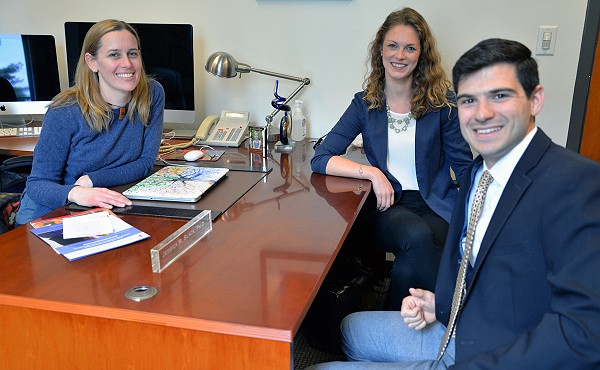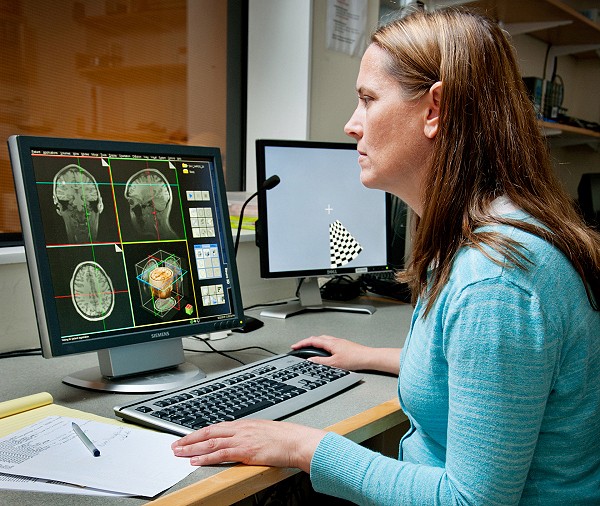
Jessica Black (left) with neuroscience alumni Stephanie Brueck and Matt Pecoraro.
When Associate Professor Jessica Black set out to establish her innovative program merging neuroscience with social work, she knew that, in order for it to be truly successful, it would need to impact the most students as possible. From the clinical concentrator dedicated to serving those living at the margins on the front lines, to the macro specialist with aspirations of one day occupying a major public office, each could benefit greatly from understanding the impact of social context on brain development.
Black pursued higher education in the first place in hopes of preparing a next generation of social workers to transform the world for good. A Stanford-trained educational neuroscientist, she redirected her own course of study away from the natural sciences and towards social work because she strongly believed in what MSW graduates could accomplish. She knew that there existed a fertile space between two fields just waiting to be cultivated, and that she had the background and training to start something special.
Now five years into her project here at BC Social Work, Black’s program is flourishing. To date, more than 10 students have completed BCSSW’s neuroscience and social work certificate and many more take the elective neuroscience courses that fill a waitlist every year; in 2015 Black chaired the inaugural Social Work and Intersections Symposium and Conference held on campus featuring a keynote from renowned MIT neuroscientist John Gabrieli; and she continues to publish widely on neuroimaging, humor, and resilience in children. But perhaps most importantly, certainly in her view, is that already, a growing network of neuroscience BCSSW alumni is making inroads towards effecting the kind of systemic change Black envisions can be possible.
“Jessica is the rare scholar and teacher who can take two seemingly disparate areas such as neuroscience and social work and meld them seamlessly into a coherent scientific framework,” says Associate Dean for Research David Takeuchi. “She also has the exceptional capacity to convey her excitement and knowledge about neuroscience to social work students and they in turn respond with energy and enthusiasm to integrate neuroscience into their own research and practice.”
Students such as recent alumni Stephanie Brueck and Matt Pecoraro, who embody the diversity of opportunity inherent for those who understand how neuroscience impacts social work, and vice versa.
Brueck, a clinical concentrator who graduated from BC Social Work in 2015, is the Senior Coordinator for the Intergenerational Mobility Project for EMPath, a data-driven nonprofit organization dedicated to breaking the cycle of poverty in America. Thanks in no small part to Brueck, EMPath has recognized that their mission to apply existing anti-poverty models for adults to entire families benefits greatly from understanding brain science. They’ve established a partnership with Harvard’s Center on the Developing Child to this end; much of Brueck’s work is to educate existing and potential partners on this synergistic relationship. So cutting edge is EMPath’s program, that it was recently highlighted in both The Boston Globe and The Atlantic.
Impressively, Brueck’s own opportunities for influencing the growing space between neuroscience and social work don’t stop with her day-to-day activities: She is also a co-author on a recent study that came out of her work with the Boston Children’s Hospital.
“I feel like I talk about neuroscience all the time, and I wish I could more,” she says. “Part of my job is to train other organizations to do the work that we do, and so I spend the better half of a day talking about the actual anatomy of our brain and how our brain impacts the way we are seeing the world around us and what that means for the participants in our programs.
For more on the neuroscience program at BCSSW, and Black’s take on the interdisciplinary study happening between social work and neuroscience, check out this Q&A.

Some of Black’s research uses neuroimaging to better understand the neural underpinnings of humor in children, and how this may contribute to resilience.
“At EMPath, we work hard to recognize that things have happened in our clients’ lives that have had a direct biopsychosocial impact on them. We then come together to develop interventions to best develop the executive functioning skills needed to navigate societal systems with these impacts in mind. The end goal is always to help them get to the brighter future they have set for themselves.”
Pecoraro, for his part, is the macro graduate who has found a growing niche in promoting policy through a unique, neuroscience-tinted lens. As Policy and Program Associate at Harvard Medical School affiliate the Judge Baker Children’s Center, he is tasked with building the organization’s ability to influence policy through evidence-based research. In fact, his position was created especially for his unique skill set.
“Working at Judge Baker right out of grad school really was a dream come true,” says Pecoraro. “This idea of evidence-based practice is something we talk about a lot in social work school. And so to have a direct experience at Judge Baker from a seasoned and well-respected staff of colleagues, has just been fantastic.”
Like Brueck, Pecoraro has already made his mark as a co-author, despite having graduated from BCSSW only a year ago. His policy brief Early Childhood Development: Implications for Policy, Systems, and Practice uses scientific research to delve into the policies, systems, and policies that can be enacted, amplified, improved, and more effectively connected in order to ensure a continuous high quality continuum of care for children and their families. It also draws on a major lesson learned while under Black’s tutelage: that similar principles can be applied to work with individual human beings, or with greater society on the whole.
“The idea of individual selves connecting with bigger groups which connect with bigger systems which in turn impact the function of humanity broadly is fascinating to me,” Pecoraro explains. “The uniqueness of the neuroscience coursework at BCSSW provided important perspective that I still use today, as I work to adapt takeaways from individual research projects into policy to positively impact larger populations.”
This uniqueness is one that’s recognized within the School of Social Work, and across the country.
“Jessica’s contribution to the MSW curriculum has been profound,” explains Associate Dean and MSW Program Director Tom Walsh. “She embodies trans-disciplinary work in her development of courses that focus on the neuroscience of relationships, as well as the neurobiology of stress and resilience. Having arrived at the School with an expertise in neuroscience, Jessica immersed herself in social work literature, and has become the quintessential expert in neuroscience and social work – which enables us to offer students curriculum options that are not found in other schools.”
In the end, Black would tell you that she made that slight turn to the fork in the road towards social work because of the possibility for success stories like those told by Brueck and Pecoraro, two alumni who are impacting the world in which they live in new and exciting ways. As they grow as individual professionals, so too does the community in which they work, and even beyond that. It all sounds so neuroscience. Or social work.
“I’m proud of Stephanie and Matt’s work,” she says. “They’re making an impact, and they’re also providing a proof point to something I’ve been trying to dispel since I started here at BC in 2010. That there’s a one-way missing piece, and social work needs neuroscience.
“It’s clear that this is true, but also, it’s clear that neuroscience needs to be informed by social work, and that the two can work together and learn from each other. It’s an exciting time to bridge the fields, while recognizing the unique character capacity and vantage points that both disciplines have. Stephanie and Matt are already showing, as young alumni of our school, that through communication, whether it be in academia, the nonprofit world, or in a clinical setting, neuroscience and social work can thrive, together.”

